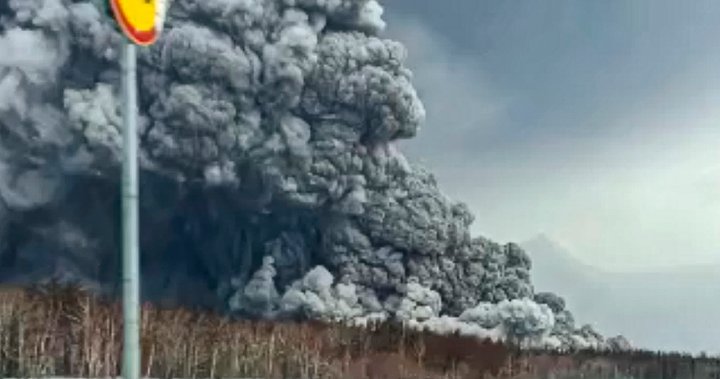Russia volcano eruption blankets towns in ash, disrupts air traffic – National | Globalnews.ca
A volcano in Russia’s far eastern region erupted early Tuesday, spewing a massive cloud of ash into the sky that blotted out the sun and smothered villages in grey volcanic dust.
The Shiveluch volcano, which is located on Russia’s northeastern Kamchatka peninsula and juts into the Pacific Ocean, erupted around 12:54 a.m. local time and was still erupting nearly 15 hours later, according to a Telegram post from the Russian Academy of Sciences’ Geophysical Survey.
Read more:
Canada ‘watching anxiously’ as U.S. probes leaked Ukraine intelligence: experts
At the height of the eruption, about six hours in, the volcano shot debris 20 kilometres into the air and the ash cloud that resulted covered an area of 108,000 square kilometres (41,699 square miles).
Screengrab from a Reuters video showing a town in Russia’s far east Kamchatka peninsula blanketed in a deep layer of volcanic ash.
Reuters
“The ash cloud moved westwards and there was a very strong fall of ash on nearby villages,” said Danila Chebrov, director of the Kamchatka branch of the Geophysical Survey.
Towns in the surrounding areas were carpeted in drifts of grey ash as deep as 8.5 centimetres — the most volcanic fallout Russia has seen in 60 years — as the ash cloud rained down.
This handout photo shows volcanic ash covering the ground in Ust-Kamchatsky district after the Shiveluch volcano’s eruption on Tuesday.
Ust-Kamchatsky municipal district/Oleg Bondarenko via AP
The village of Klyuchi, located about 50 kilometres from the volcano, was on the front lines of the eruption. Residents posted videos showing the ash cloud plunging the area into darkness.
Lava flows tumbled from the volcano, melting snow and prompting a warning of mud flows along a nearby highway. Pictures showed the ash cloud billowing swiftly over the forests and rivers of the far east.
Smoke and ash are visible during the Shiveluch volcano’s eruption on the Kamchatka Peninsula on Tuesday.
Alexander Ledyayev via AP
Around 24 hours after the volcano began erupting, a 5.8 magnitude earthquake struck off the coast of Kamchatka, the Geological Survey said. Russian scientists said the quake was an aftershock from an April 3 earthquake.
The Shiveluch volcano is one of the largest volcanoes in the Kamchatka peninsula, which is home to about 300,000 people and is considered to have some of the most concentrated geothermal activity in the whole world.
“The volcano was preparing for this for at least a year… and the process is continuing though it has calmed a little now,” Chebrov said.
Read more:
Mauna Loa, Hawaii’s biggest volcano, erupts for 1st time in 40 years
As the volcano settles, Chebrov noted that he can’t rule out the possibility that further major ash clouds will be produced. He added that the lava flows should not reach local villages.
Officials issued a red notice for aviation and closed the skies around the volcano to aircraft on Tuesday, writing that “ongoing activity could affect international and low-flying aircraft.”
There were no immediate reports of casualties resulting from the eruption, though local authorities have ordered residents to stay indoors and schools in several affected communities have been closed.
“Because what I have just seen here with my own eyes, it will be impossible for children to go to school, and in general, the presence of children here is questionable,” wrote Oleg Bondarenko, head of the Ust-Kamchatsky municipal region, in a Telegram post.
This handout photo shows volcanic ash covering the ground in Ust-Kamchatsky district after the Shiveluch volcano’s eruption on the Kamchatka Peninsula in Russia’s far east.
Ust-Kamchatsky municipal district/Oleg Bondarenko via AP
Two villages had their power networks fail in the fallout, though emergency crews were able to restore the connections. Photos on social media appeared to show residents’ tap water coming out murky, though Bondarenko wrote that drinking water is being supplied to affected communities.
One video that surfaced from the region appears to show a Russian scientist making a “snow” angel in the ash drifts left behind by the eruption.
Screengrab from a Reuters video showing a Russian scientist making a snow angel in volcanic ash, following the eruption of a volcano in Russia’s far east.
Reuters
Shiveluch has had an estimated 60 substantial eruptions in the past 10,000 years, the last major one being in 2007.
It has two main parts, the smaller of which, Young Shiveluch, was reported by scientists as being extremely active in recent months. Young Shiveluch has a peak of 2,800 metres and protrudes out of the 3,283 metre-high Old Shiveluch.
— With files from Reuters
© 2023 Global News, a division of Corus Entertainment Inc.
For all the latest world News Click Here





